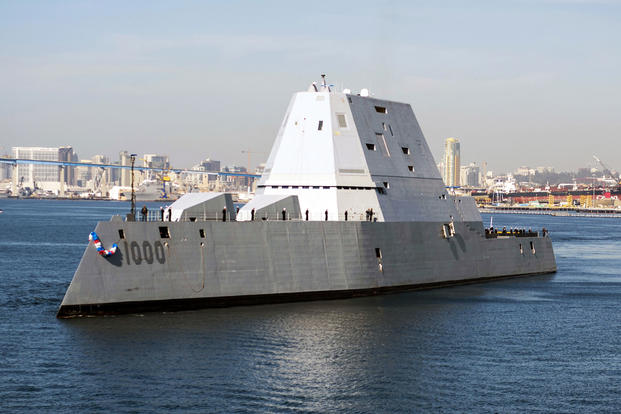The Nuclear Posture Review (NPR) includes a long-term plan that could put nuclear cruise missiles aboard the new Zumwalt class (DDG 1000) of stealthy Navy destroyers, according to the commander of U.S. Strategic Command.
Air Force Gen. John Hyten, StratCom chief, said the plan to develop a new, low-yield nuclear Sea-Launched Cruise Missile (SLCM, or "Slick-em") would not be limited to using ballistic submarines as the sole launch platform, as many assumed when the NPR was endorsed by Defense Secretary Jim Mattis earlier this month.
"It's important to know that the NPR, when it talks about the Sea-Launched Cruise Missile, does not say 'Submarine-Launched Cruise Missile,' " Hyten said in a Feb. 16 keynote address in Washington, D.C., at the National Defense University's Center for the Study of Weapons of Mass Destruction.
In response to questions, he said, "We want to look at a number of options -- everything from surface DDG 1000s into submarines, different types of submarines" for the SLCMs.
Related: At $800K a Pop, New Navy Destroyer's Ammo Is in Question
"That's what the president's budget has requested of us -- to go look at those platforms, and we're going to walk down that path," Hyten said.
The USS Zumwalt, the first of three new stealthy destroyers billed by the Navy as the world's largest and most technologically advanced surface combatants, experienced numerous cost overruns in construction and problems in sea trials. It also broke down while transiting the Panama Canal in 2016.
The second ship in the Zumwalt class, the Michael Monsoor, had to cut short sea trials in December because of equipment failures.
The NPR called for the development of two new, low-yield nuclear weapons -- the SCLM and a new submarine-launched ballistic missile.
Hyten said the U.S. will be modifying "a small number of existing submarine-launched ballistic missile warheads to provide a prompt, low-yield capability, as well as pursuing a modern nuclear-armed sea-launched cruise missile in the longer term."
He added, with some regret, that both are necessary to enhance U.S. deterrence against growing tactical and strategic nuclear threats from Russia and China.
"I don't have the luxury of dealing with the world the way I wish it was," he said. "We, as a nation, have long desired a world with no or at least fewer nuclear weapons. That is my desire as well. The world, however, has not followed that path."
New developments with the Xian H6K strategic bomber, a version of the Russian Tupolev Tu-16 twin-engine bomber, has given China a nuclear triad of bombers, land-based missiles and submarines "for the first time," Hyten said.
He also cited repeated statements from Russian President Vladimir Putin about modernizing his own nuclear force and developing a new generation of low-yield weapons. "Russia has been clear about their intent all along," he said.
In the question-and-answer period at National Defense University, an official from the Russian Embassy in Washington challenged the general's assessment of the threat posed by his country.
Hyten responded, "We listen very closely to what your president says, and then watch closely" through a variety of means to see Putin's thoughts put into action. "We have to consider those a threat."
Earlier, he said, "Our adversaries are building and operating these strategic weapons, not as a science experiment, but as a direct threat to the United States of America."
In an address preceding Hyten's, Pentagon policy chief David Trachtenberg said that the new NPR developed for the Trump administration should not be seen as a divergence from the 2010 NPR adopted by the Obama administration.
"Contrary to some commentary, the Nuclear Posture Review does not go beyond the 2010 NPR in expanding the traditional role of nuclear weapons," said Trachtenberg, deputy undersecretary of defense for policy.
"The goal of our recommendations is to deter war, not to fight one," he said. "If nuclear weapons are employed in conflict, it is because deterrence failed, and the goal of the 2018 NPR is to make sure that deterrence will not fail."
However, "it is clear that our attempts to lead by example in reducing the numbers and salience of nuclear weapons in the world have not been reciprocated," Trachtenberg said.
Russia and China have made clear their intentions to "expand the numbers and capabilities" of their nuclear arsenals, he said.
-- Richard Sisk can be reached at Richard.Sisk@Military.com.











